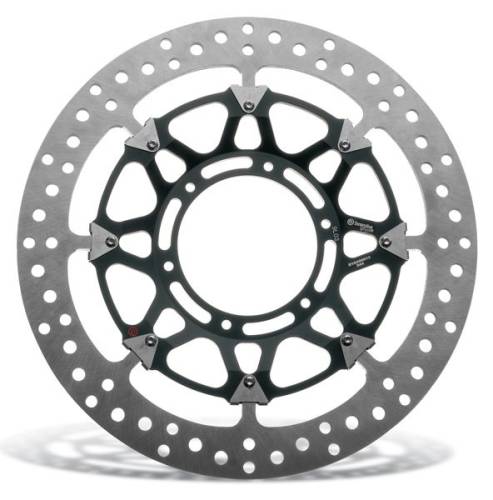Motorcycle Brakes Buyers Guide

When you’re investing in a motorcycle, the power and capability of the vehicle itself might be your first priority. However, even more importantly than your motorcycle’s power is your motorcycle’s safety features, especially its brakes. Arguably the most important part of any vehicle is the ability to stop it after you’ve started. This guide will give you a rundown of two very important parts of motorcycles’ brake systems and give you an idea of the best ones for your needs.
Rotors
The rotors of a motorcycle’s brake system are an essential part of any bike. They use a vented or cross-drilled design that allows for easier cooling of the brake system as well as lower weight, which heightens the capability of your bike. There are two types of rotors that are used in motorcycle brake systems: fixed rotors and floating rotors.
Fixed rotors are exactly what the name implies: they are fixed in one place. They are made of a solid piece of steel that is cut or otherwise crafted into a disc shape. They are much easier to manufacture than floating rotors, and as a result they are much less expensive. They are also better for extreme riding conditions, because they are made of the one part alone rather than multiple intertwined moving parts.
Floating rotors are rotors in which the rotor blade can sit independently of the carrier that mounts it to the wheel, allowing it to “float”. These rotors allow for the most stopping power in a manner that is consistent and predictable. These rotors also lower the average temperature of braking, which is incredibly important because excessive exposure to heat can reduce braking performance.
Brake Pads
In order for a motorcycle to stop, brake pads must clamp against the spinning rotor; these two parts work together to stop your motorcycle. There are three major types of brake pads, all of which offer different qualities and benefits that you can choose from depending on your preferences.
Organic brake pads are known as the “softer” brake pad, meaning that they allow for a progressive stoppage of your bike with a slow, gradual, comfortable feel. These pads push friction-generated heat back into the rotor so that it does not negatively affect other parts of your bike. They are non-abrasive and as such are kinder to rotors, although they have a shorter lifespan than the other kinds of brake pads. These brake pads are great for people with less demanding braking requirements.
Sintered brake pads are the most common aftermarket replacement for brake pads among motorcycle owners. They are created with ultra-high friction which allows for massive stopping power, and they have a longer lifespan than other brake pads. While these pads allow for rapid braking, this capability makes the heat transfer through the pads much greater, which can be damaging. However, sintered brake pads tend to have insulation materials to lessen the effect of this. These brake pads are most commonly used on race tracks or in cities.
Semi-sintered brake pads combine the best of both worlds from both organic and sintered brake pads. They have a longer lifespan than organic brake pads but a shorter lifespan than sintered brake pads. They allow for a similar feel to sintered pads with less heat transfer and damage to the rotors, making them great for people seeking durability or those interested in off-roading.
Now that you’re an expert on two major parts of your motorcycle’s braking system, the choice is up to you. If you’re seeking to change your rotors or brake pads at the best aftermarket quality and value possible, you can find everything you’re looking for and more from us at HHR Performance. We can cover all of your brake part needs, and you can rest easy knowing that we devote ourselves to the highest level of performance and customer satisfaction in the business.




You must login to post comments.